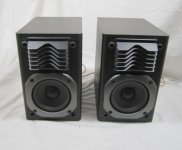Hello! Usually this question regarding upgrading cheap speakers gets asked a lot and as a somewhat more experienced DIYer I know there's never a precise answer without having a proper testing procedure to back it up.
However, I have a measurement microphone and made myself a DIY impedance measurement rig, so this time I had a way to measure the drivers that are part of the Panasonic SB-PM01. It's a 2-way bass reflex mini speaker with a 4" midwoofer and a 2" cone tweeter.
I want to improve this very basic pair of speakers for a fun project.
The speakers and the drivers themselves look pretty nice, the box is also very sturdy, the bass reflex pipe is tapered both ways. There's no sound deadener in it.
The drivers have an "M" logo stamped on them and the part numbers, which is T10P12A6 for the 4" woofer and 6PH322A6 for the 2" cone tweeter.
The original measured response doesn't look great, it's tilted up by quite a lot and there are a lot of peaks and dips especially in the midrange. My explanation is that because the midwoofer has no crossover, and the tweeter only has the typical 2,2uF NP protection cap, they overlap by quite a lot in the midrange causing all sorts of phase issues. This is confirmed by the fact that the off-axis response is much worse.
So, my plan for these speakers is to use them to make a decent sounding pair of speakers, starting by a new crossover which will improve the midrange and the soundstage and then adding some deadener which will take care of that 150Hz peak.
I measured the woofer, then the tweeter, and then both of them in parallel to get the z-axis offset right.
I think I made a pretty decent crossover in X-sim. The response graph looks pretty nice and the impedance graph drops down to about 3,34 ohms at 5,5kHz. This shouldn't be an issue with most modern amplifiers.
Here are some pictures of the drivers and the measured response of the speakers as they came from the factory (scale is 10db/div):

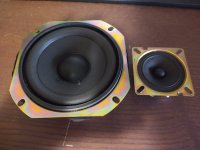
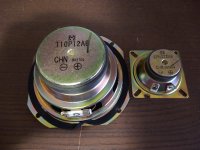
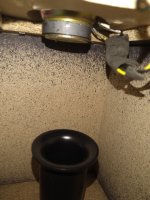
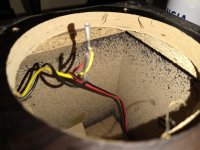
This is a screenshot of the crossover project so you don't have to download it in order to see it (the scale is 3db/div):

What do you guys think of it? Do you think it can be improved?
I'm attaching the project files.
Thanks a lot!
However, I have a measurement microphone and made myself a DIY impedance measurement rig, so this time I had a way to measure the drivers that are part of the Panasonic SB-PM01. It's a 2-way bass reflex mini speaker with a 4" midwoofer and a 2" cone tweeter.
I want to improve this very basic pair of speakers for a fun project.
The speakers and the drivers themselves look pretty nice, the box is also very sturdy, the bass reflex pipe is tapered both ways. There's no sound deadener in it.
The drivers have an "M" logo stamped on them and the part numbers, which is T10P12A6 for the 4" woofer and 6PH322A6 for the 2" cone tweeter.
The original measured response doesn't look great, it's tilted up by quite a lot and there are a lot of peaks and dips especially in the midrange. My explanation is that because the midwoofer has no crossover, and the tweeter only has the typical 2,2uF NP protection cap, they overlap by quite a lot in the midrange causing all sorts of phase issues. This is confirmed by the fact that the off-axis response is much worse.
So, my plan for these speakers is to use them to make a decent sounding pair of speakers, starting by a new crossover which will improve the midrange and the soundstage and then adding some deadener which will take care of that 150Hz peak.
I measured the woofer, then the tweeter, and then both of them in parallel to get the z-axis offset right.
I think I made a pretty decent crossover in X-sim. The response graph looks pretty nice and the impedance graph drops down to about 3,34 ohms at 5,5kHz. This shouldn't be an issue with most modern amplifiers.
Here are some pictures of the drivers and the measured response of the speakers as they came from the factory (scale is 10db/div):




This is a screenshot of the crossover project so you don't have to download it in order to see it (the scale is 3db/div):
What do you guys think of it? Do you think it can be improved?
I'm attaching the project files.
Thanks a lot!
Hmm, kind of tough to quickly compare 3 dB Vs 10 dB plots, but obviously a lot flatter, though without an audition, not sure I'd want that in a mini-system, i.e. like all DIY efforts, all that matters is 'does it subjectively or otherwise make a worthwhile improvement to you in your intended app'. 😉
WTH does that tweeter cover do? 😆 Were your responses taken with the cover in place?
I don't see any project files.
I don't see any project files.
Those speakers have an acoustic lens on them, but one of them has a broken mounting tab and I'll have to fix it.WTH does that tweeter cover do? 😆 Were your responses taken with the cover in place?
I don't see any project files.
To my knowledge its purpose is to make the cone tweeter beam less at high frequency. However it didn't make a big difference on the on-axis measured response whether I had it installed or not, so it will stay because it also looks rather nice!
The measurement were taken with the lens installed.
I also somehow managed to forget to attach the project files - here they are!
I've done lots of "fiddling" with these cheap speakers and the biggest improvement I've usually made is filling the box with good acoustic fibre or if ported lining the box with felt blanket or some foam behind the woofer. Some have benefited from swapping to a better tweeter
I will be adding PU based sound deadener to the insides because I have plenty of it, also according to my experience it works really well.
It won't help with the huge rising response, they will always sound piercing if I don't fix the crossover, even more so because the low-mids will be rolled off because of the added losses.
Also, here's the same graph using a 10db/div scale! Do not check the response under 300 hertz because my measurement started there. I didn't want to start the sweep at 20hz in fear I may toast the tweeter. Also I don't really care for what happens there because the crossover frequency is much higher.
Attachments
I had a quick look but stopped cause of the tweeter. Based on your files, there's a 10db peaking from 10khz that I can't flatten.
I wonder if it's related to that "acoustic lens" - can it be removed?

I wonder if it's related to that "acoustic lens" - can it be removed?
I had a quick look but stopped cause of the tweeter. Based on your files, there's a 10db peaking from 10khz that I can't flatten.
I wonder if it's related to that "acoustic lens" - can it be removed?
View attachment 1079529
I believe that is due to the tweeter paper cone breaking up. that sort of response is typical of most 2" cone tweeters. I've taken some more measurements with the mic 5mm (or 1/5") from the tweeter without the lens on. I wouldn't worry about that too much as it's very high up in frequency tho.
Also, looks like I forgot to include the microphone calibration file in the previous measurements😵
I will correct for it and re-send.
Attachments
Last edited:
I was able to add the corrected measurement in the previous message, the right .frd files to use are labeled WOOFER-2, TWEETER-2 AND WOOFER+TWEETER-2
A thin airbrush coating of Dammar typically solves the problem or can use an inexpensive mechanic's stethoscope to find and blob a drop on them like we did in the bad old days.
I'm not too much of a fan of applying oils on speakers because it's impossible to go back if I don't like how it changed the response.
Also there's the big issue that nobody here has the slightest idea about what Damar is so it's very hard to get, I think they call it different.
I suppose I could use the Ciare YAC903 speaker paint but I would like to avoid it... The first breakup node is at 13kHz and I can just live with it.
Also there's the big issue that nobody here has the slightest idea about what Damar is so it's very hard to get, I think they call it different.
I suppose I could use the Ciare YAC903 speaker paint but I would like to avoid it... The first breakup node is at 13kHz and I can just live with it.
Last edited:
re:'nobody here has the slightest idea about what Damar is': Damar is a varnish used by artists, get it at your local art supply store. The stuff made specifically for audio is a scam.
I'm with GM, treat the cones. I'd paint 3 or 4 radial stripes of Rustoleum 'Leakseal' on the woofer to tame the breakup.
I'm with GM, treat the cones. I'd paint 3 or 4 radial stripes of Rustoleum 'Leakseal' on the woofer to tame the breakup.
Thank you for the explanation. I need to treat the tweeter, not the woofer, which has a very thin and flimsy paper cone (and a paper surround as well).
I'm a bit worried I might kill the high end by too much, and I don't feel confident enough to touch the cones with a brush because they're so flimsy. I think I can live with the break up because it's so high up in frequency.
The woofer is not really a problem. It breaks up at about 8/9kHz which is far above the crossover point.
I think I somehow improved with the crossover after following motokok's scheme (third order and a single resistor). There's almost no overlap in the midrange compared to the second order crossover. I think it might also help with the tweeter distortion and power handling. The impedance also never goes under 5.9 ohms.

This is another try I made with a second order crossover on the tweeter. The impedance now looks very good!

It's the "overlap" in the 1/2kHz region that worries me. I don't think that may cause problems off-axis because the speakers are way closer than the wavelenght of 2kHz, however I am worried that the tweeter might distort because it's crossed close to the Fs with a shallow filter.
On the upside, the frequency response looks a bit more linear in the midrange because there's a some subtraction and I also need to buy one less part.
What do you guys think? Which kind of design is better?
I'm a bit worried I might kill the high end by too much, and I don't feel confident enough to touch the cones with a brush because they're so flimsy. I think I can live with the break up because it's so high up in frequency.
The woofer is not really a problem. It breaks up at about 8/9kHz which is far above the crossover point.
I think I somehow improved with the crossover after following motokok's scheme (third order and a single resistor). There's almost no overlap in the midrange compared to the second order crossover. I think it might also help with the tweeter distortion and power handling. The impedance also never goes under 5.9 ohms.
This is another try I made with a second order crossover on the tweeter. The impedance now looks very good!
It's the "overlap" in the 1/2kHz region that worries me. I don't think that may cause problems off-axis because the speakers are way closer than the wavelenght of 2kHz, however I am worried that the tweeter might distort because it's crossed close to the Fs with a shallow filter.
On the upside, the frequency response looks a bit more linear in the midrange because there's a some subtraction and I also need to buy one less part.
What do you guys think? Which kind of design is better?
I assembled the new crossover! I've decided to make the third order crossover because I already had very similar components to the ones required.
This is the "final" circuit schematic:

This is how I assembled the crossover.
I've hot-glued everything in place on a MDF board I had laying around, used MKT capactors salvaged from an old speaker's crossover I got for really cheap.
The inductors also were salvaged from a three-way Coral car audio crossover. I had to unwind the smaller one to the value that I needed, The air-cored one has 0,5ohm ESR and the iron-cored one has 0,6ohm ESR. The resistors are matched to 0,03ohm. I only had to buy the 5,6uF capacitor that I didn't have.


This is how I mounted the crossoverin the enclosure. I used hot glue to stick it to the box in case I ever needed to take it out. If I had used wood glue it would've been impossible, and I couldn't screw it in place because of how cramped it was in there.
I also added some sound dampening, but after I took the picture I had to add more because I noticed some nasty resonances in the 2kHz region and the midbass was still too loud.
Here is the measured in-room response after all those modifications:

If we compare with the old one (below), it is much better:

Overall, I'm very satisfied with my work! They now sound like good speakers.
The bass is surprisingly good. I didn't expect that bass extension from a cheap 4" woofer. The ripple isn't excessive and doesn't shift the tonal balance too much, although if I had used a lower ESR inductor for the woofer it would've been better. Someone was worried about that peak at around 14kHz but it's not very audible, I think I like it even! It doesn't sound fatiguing, but it makes the speaker sound a bit more "open".
Soundstage is what I like the most about them and is also what I think benefitted the most from the crossover upgrade. It's astonishingly wide and deep. They have a very solid stereo image. The midrange is beautiful too. Vocals sound very impressive.
They also do well at higher volumes, for such a small speaker at least. The woofer seems to have a decent excursion.
Overall, I would recommend the upgrade to anyone who already has this pair of speakers, or can get one for cheap and has at least some crossover parts laying around. At least to my ears, they sound a lot better than the very common JBL Control One and also the JPW Mini Monitor which I have.
I always find impressive by how much a speaker can improve with just a crossover redesign.

This is the "final" circuit schematic:
This is how I assembled the crossover.
I've hot-glued everything in place on a MDF board I had laying around, used MKT capactors salvaged from an old speaker's crossover I got for really cheap.
The inductors also were salvaged from a three-way Coral car audio crossover. I had to unwind the smaller one to the value that I needed, The air-cored one has 0,5ohm ESR and the iron-cored one has 0,6ohm ESR. The resistors are matched to 0,03ohm. I only had to buy the 5,6uF capacitor that I didn't have.
This is how I mounted the crossoverin the enclosure. I used hot glue to stick it to the box in case I ever needed to take it out. If I had used wood glue it would've been impossible, and I couldn't screw it in place because of how cramped it was in there.
I also added some sound dampening, but after I took the picture I had to add more because I noticed some nasty resonances in the 2kHz region and the midbass was still too loud.
Here is the measured in-room response after all those modifications:
If we compare with the old one (below), it is much better:
Overall, I'm very satisfied with my work! They now sound like good speakers.
The bass is surprisingly good. I didn't expect that bass extension from a cheap 4" woofer. The ripple isn't excessive and doesn't shift the tonal balance too much, although if I had used a lower ESR inductor for the woofer it would've been better. Someone was worried about that peak at around 14kHz but it's not very audible, I think I like it even! It doesn't sound fatiguing, but it makes the speaker sound a bit more "open".
Soundstage is what I like the most about them and is also what I think benefitted the most from the crossover upgrade. It's astonishingly wide and deep. They have a very solid stereo image. The midrange is beautiful too. Vocals sound very impressive.
They also do well at higher volumes, for such a small speaker at least. The woofer seems to have a decent excursion.
Overall, I would recommend the upgrade to anyone who already has this pair of speakers, or can get one for cheap and has at least some crossover parts laying around. At least to my ears, they sound a lot better than the very common JBL Control One and also the JPW Mini Monitor which I have.
I always find impressive by how much a speaker can improve with just a crossover redesign.
Thanks for the update! I especially like your creative use of existing crossover components. 😎
You've travelled a long way from an unfiltered midwoofer & tweeter with 2.2 uF cap, and I'm glad you're satisfied with the result.
You've travelled a long way from an unfiltered midwoofer & tweeter with 2.2 uF cap, and I'm glad you're satisfied with the result.
Yes they're now more like a pair of proper speakers!
I always try to source components from already existing circuits unless I need something particular. It is much cheaper to buy batches of used passive crossovers than to buy single components and I also end up saving perfectly valid parts from polluting the planet. But I always avoid NP caps as they usually fail with age and they aren't very good.
I always try to source components from already existing circuits unless I need something particular. It is much cheaper to buy batches of used passive crossovers than to buy single components and I also end up saving perfectly valid parts from polluting the planet. But I always avoid NP caps as they usually fail with age and they aren't very good.
How did you measure the bass, that is SPL below approx 150 Hz? This does not look look a nearfield measurement.
I've placed the speaker on a blanket, which in turn I put it on my bed. It was 1 meter away from the rear and lateral wall. The microphone was placed about 75cm away from the speaker, aimed between the woofer and the tweeter. The room is treated acoustically.
I also moved the speaker the other way (about 3 meters away from the nearest wall) and it didn't change much. CouIdn't make a measurement that was somewhat reliable for the high frequency because I didn't have a stand and I had to hold it in hand. I suspected an underdampened alignment.
I also moved the speaker the other way (about 3 meters away from the nearest wall) and it didn't change much. CouIdn't make a measurement that was somewhat reliable for the high frequency because I didn't have a stand and I had to hold it in hand. I suspected an underdampened alignment.
- Home
- Loudspeakers
- Multi-Way
- Panasonic mini speakers 2-way crossover mod (with measurements)
